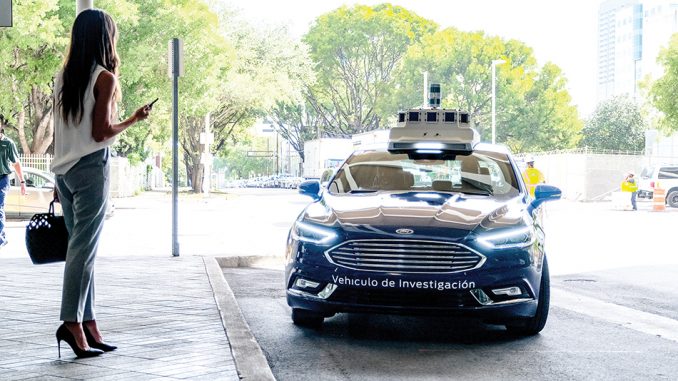
MIAMI — After billions of dollars and years of research, self-driving cars are finally here. Sort of. If you live in the right city. And it’s glorious.
Google is launching its robot taxi service, called Waymo One, outside Phoenix. General Motors’ robot subsidiary Cruise AV has been testing its self-driving cars in San Francisco, preparing its autonomous taxi service for public launch. And Ford is doing its development down in sunny (and rainy) Miami, where it recently hosted journalists for a look at all the ways robot cars can benefit both passengers and businesses.
For the past 10 years, imagining the benefits of self-driving vehicles has been more of a theoretical exercise: “Wouldn’t it be cool if we could have a robot deliver pizza?” But now, Ford and its partners are doing the groundwork to make this stuff a reality.
For instance, Ford partnered up with Domino’s to develop a test platform for autonomous pizza delivery. In a mocked-up “self-driving car” that’s being driven by a normal person behind tinted windows, the companies have been testing a computerized pizza delivery system — the idea isn’t to develop the car but to instead figure out how customers will interact with the car.
In the current version, when the self-driving pizzamobile pulls up in front of your house, you walk out to greet it and enter a pin number on a touchscreen mounted on the side. Once you’re authenticated, a door opens to reveal your order. It all sounds very simple, but training humans to do anything isn’t easy. The first version didn’t have any audible prompts, so a number of customers were unsure what to do next. Now, the car tells the customer to interact with the touchscreen, and there’s a huge “START HERE” sign with an arrow pointing toward the screen.
If this all sounds like boring, nitty-gritty stuff, that’s because it is. For decades, folks have been expecting pizza to be hand-delivered to their door. Delivering it by autonomous car requires a change in behavior and expectations, and that’s what Ford and Domino’s are researching.
Will people even want to get up from their couch to retrieve a pizza from the curb? Will they want a discount? How will it all work? These are all questions that need to be answered eventually, and the fact that companies are working on this today shows how close we really are to a self-driving future. We’ve moved beyond “can the car drive itself?” The answer to that is increasingly yes. Now the question is: “What can we do with this car that drives itself?”
Ford, for its part, thinks there is a whole world of opportunities around businesses that need to move things around. And it’s doing research there too. It partnered with a local dry cleaner and a florist — both small businesses, not massive companies like Domino’s — to see if a self-driving car could help them out too. Again, the focus was on the people and the business, not the technology of the car itself.
The florist, for example, needed a custom floor in the cargo area to drop vases in to keep them stable. The dry cleaner found that the Ford Explorer they were using was better for picking up dirty clothes (as that vehicle isn’t particularly tall, so long clothes couldn’t hang straight) than for delivering clean ones. Every business will be slightly different, but Ford thinks they’re only scratching the surface. Last month, Ford expanded the tests even further, partnering with Walmart to test how autonomous grocery delivery will work.
It’s likely that you won’t be getting your groceries or pizza or flowers delivered by an autonomous car any time soon. But Ford’s research — and that of all the other car companies competing in the same space — will lay the ground work for the future of how people and our stuff get around.
Ideally, we’ll be able to be more productive and more comfortable and save money at the same time. Volvo recently showed off a concept vehicle interior that it says could replace short plane flights (think Raleigh to D.C. or Atlanta). Grocery delivery could help poor and underserved areas — food deserts — have access to high-quality grocery stores. And self-driving, on-demand delivery vehicles could help small business expand without needing to hire a new, expensive employee right away.
The future is coming. Unless you’re in Miami of course, where it’s already here.



